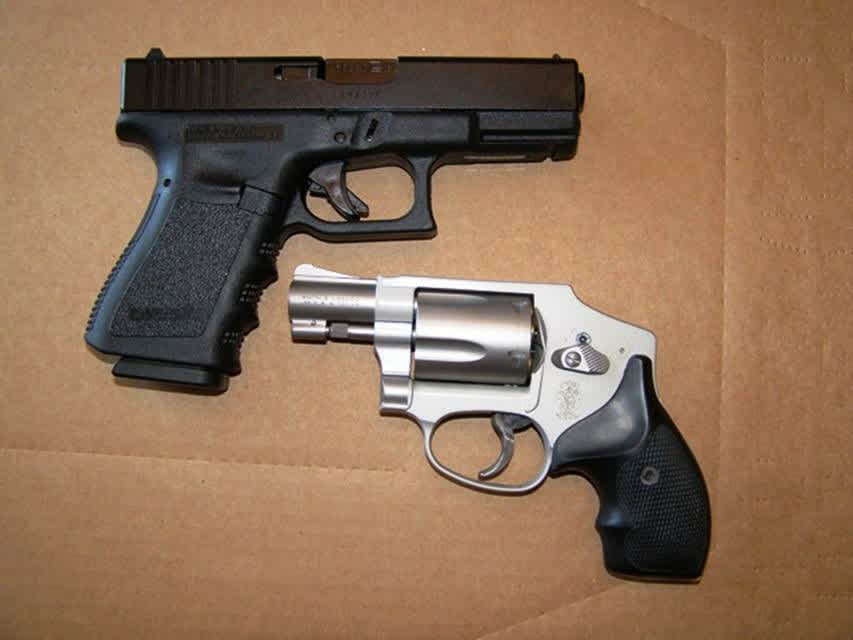How to Choose a Weapon for Personal Defense
The Box O Truth 05.16.11

The decision to defend yourself and your family is one we each must make. Today we will assume that a person has decided to take on the responsibility to defend themselves from bad guys.
The next decision is, “What weapon should I use for this task? What is the best weapon system for me?”
Weapons systems can be divided into three groups: Rifles, Shotguns, and Pistols. Each group has advantages and disadvantages. Today we will talk about handguns.
Handguns come in two main types, revolvers and semi-automatic pistols.
Handguns have these advantages:
- They are relatively small and can be easily concealed and carried. This is the main purpose of handguns, i.e., they are easy to carry around with you all day as you go about your normal business.
- They can also be used in the home and are easy to keep in the bedside drawer for easy access if needed.
Handguns have these disadvantages:
- They are much less effective at Stopping a bad guy than rifles or shotguns. As a young Patrolman, I suffered from the same misunderstanding as many folks do. I believed, based upon watching a lot of television, that a handgun was some kind of a “death ray” and would immediately Stop anyone shot with one. I later found out that some bad guys have literally been shot full of holes with handguns and continued to fight for a relatively long period of time.
- Handguns are also more difficult to shoot accurately, but this is not too critical in a home defense situation where distances are relatively short.
Some folks ask, “If I use a handgun, what caliber should I use?” The answer is that you should only use a handgun that can shoot ammo that will meet or exceed the FBI minimum penetration standard. After much research, the FBI determined that for ammunition to be effective at “Stopping” a bad guy, it must be able to penetrate at least 12 to 18 inches in ballistics gelatin.
As an aside, be sure to understand that what we want any weapon system to do is to “Stop” a bad guy from doing whatever he is doing that is threatening us or our loved ones. We do not necessarily want to kill him, but death is a very real possibility if we must Stop him. And to Stop him, the ammunition must penetrate deeply enough to reach vital organs or the central nervous system, from any angle, and possibly through arms, legs, clothing, etc.
Some folks say, “It is only a few inches from the front of a normal person’s chest to their heart. Why must a round penetrate 12 inches?” But if you think about it, a bad guy that is pointing a gun at you may require a bullet to penetrate through his arms, hands, and clothing before the bullet even begins to penetrate his chest. That is why the FBI set the standard at a minimum of 12 inches of penetration.
Any of the normal centerfire calibers such as .38 Special, 9mm, .40 S&W, .357 Sig, or .45 ACP will meet this standard with the best ammunition. And with the best ammunition, there is very little difference in the effectiveness between these calibers, contrary to popular opinion.
The next decision a person must make is whether to use a revolver or a semi-automatic handgun. Either can be used effectively if the owner is willing to train with the system.
The revolver has the advantages of being very simple to operate. It has a long double action trigger pull that makes it “safe” for most non-gunny users to operate. A person is not likely to pull the long double action trigger by accident.
A revolver has a very natural “point and click” interface for most folks. It takes very little instruction to train someone to be able to hit a man-sized target at across-the-room distances. Revolvers do not have a “Safety” that must be disengaged for firing the piece, and they depend on the long double action trigger pull as the primary safety.
A semi-automatic handgun has the advantage of using a removable magazine to reload the piece. This allows very quick reloads if needed. Semi-automatic handguns also usually have a Safety that must be released to fire the weapon. (An exception is the Glock pistols, where a trigger Safety is used, but no other external Safety is available.) They also must be charged by pulling the slide to the rear and releasing it to feed the first round into the chamber. Of course, this can be done ahead of time and then the user depends on the Safety to prevent accidental firing of the pistol.
But therein lies the problem for many users, especially women or others that are not really interested enough in firearms to practice and train frequently. Many non-gunny women may find the controls on a semi-automatic to be confusing and hard to remember how to operate. This is especially true when under a lot of stress. And a handgun that you can’t “work” is of very little use.
I often suggest a revolver for non-gunny folks as their best choice. But if they are willing and able to train and practice frequently, than a semi-auto can be an excellent choice.
In the next installment, we will discuss the shotgun as a defensive weapon system.

